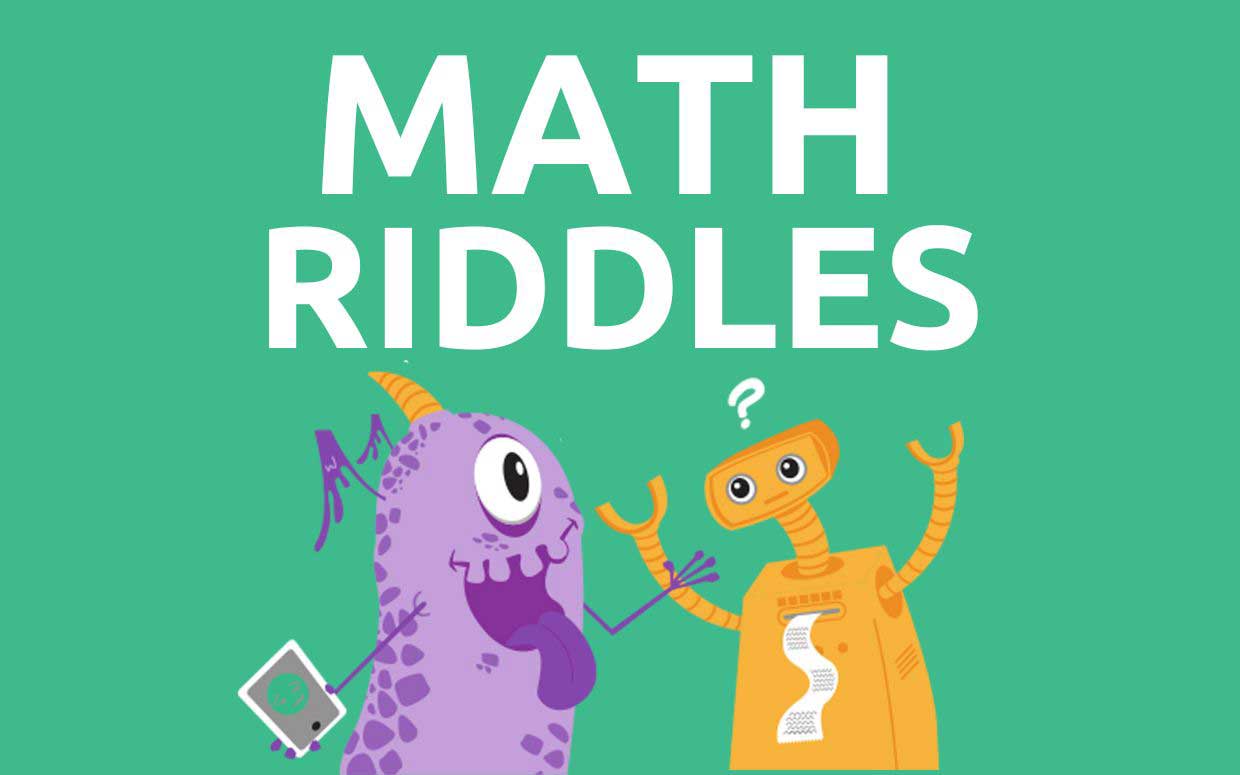
Riddle:
How can you give someone $63 using six bills, without using any one dollar bills?
Answer: 1 - $50 bill, 1 - $5 bill , 4 - $2 bills
Riddle:
If seven cats kill seven rats in 7 minutes, how many would be needed to kill one hundred rats in 50 minutes?
Answer: 14.
Riddle:
A book costs $1 plus half its price. How much does it cost?
Answer: $2
Riddle:
Two cyclists began a training run, one starting from Moscow and the other starting from Simferopol.
When the riders were 180 miles apart, a fly took an interest. Starting on one cyclists shoulder, the fly flew ahead to meet the other cyclist. After reaching him the fly then turned around and yet back.
The restless fly continued to shuttleback and fourth until the pair met; then settled on the nose of one rider.
The flys speed was 30 mph. Each cyclist speed was 15 mph.
How many miles did the fly travel?
Answer: The cyclists took 6 hours to meet. The fly traveled 6*30=180 miles.
Riddle:
Using only brackets, parentheses, and these signs +,-, X, /. How can you express 100 with 5 1's and express 100 three ways with five 5's?
Answer: 111-11=100
(5 x 5 x 5)-(5 x 5)=100; (5+5+5+5)x 5=100;(5 x 5)(5-(5/5)=100.
Riddle:
(A) Use two digits to make the smallest possible positive integer.
(B) Five 3s can express 37: 37=33+3+3/3
Find another way to do it.
(C) Use six identical digits to make 100. (Several solutions are possible.)
(D) Use five 4s to make 55.
(E) Use four 9s to make 20.
Answer: (A) 1 X 1; 1/1;2/2;ect....;1-0;2-1;and many others.
(B) 37=333/3X3; 37=3 X 3 X 3 + 3/.3
(C) 99 + 99/99; 55+55- 5- 5; (666-66)/6
(D) 44 + 44/4=55.
(E) 9 + 99/9=20.
Riddle:
The title of the problem tells you how to approach these four questions.
(A). A bus leaves Moscow for Tula at noon. An hour later a cyclist leaves Tula for mosco, moving slower than the bus. When the bus and cyclist meet, which one of the two will be farther from Moscow?
(B). Which is worth more: a pound of $10 gold peices or half a pound of $20 gold pieces?
(C). At six o'clock the wall clock struck 6 times. Checking with my watch, I noticed the time between the first and last strokes was 30 seconds. How long will the clock take to strike 12 at midnight?
(D). Three swallows fly outward from a point. When will they all be on the same plane in space?
Now check the answers. Did you fall into any of the traps which lurk in these simple problems?
Answer: (A). Neither
(B). A pound of metal is always more than half a pound of the same metal.
(C). Six strokes took 30 seconds, therefore 12 strokes will take 60 seconds. But when the clock struck six, there were only 5 intervals between strokes, and each interval was 30/5=6 seconds. Between the first and twelfth strokes there will be 11 intervals of 6 seconds each, therefore 12 strokes will take 66 seconds.
(D). There is always a plane that contains any 3 points
Riddle:
As I traveled up and down our great glorious country, I found myself in a place where the tempature goes up sharply in the day and down at night. This had an effect on my watch, I noticed it was 1/2 a minute faster at nightfall, but at dawn it had lost 1/3 minute, making it only 1/6 minute fast.
One morning- May 1- my watch showed the right time. By what date was it 5 minutes faster?
Answer: In 24 hours the watch gained 1/2-1/3= 1/6 minute. It would seem it would be 5 minutes fast in 5 X 6= 30 days; that is,the morning of May 31. But already on the morning of May 28 the was 27/6= 4 1/2 minutes fast. At the close of the day the watch gained 1/2 minute more, so it was 5 minutes fast on may 28.
Riddle:
Three pirates, One Eye, Long John, and Peg Leg, were gambling with pieces of gold. All the winnings were piled up on the table. One Eye said, 'I have won 1/2' and took a large handful or two. Long John said, 'I have won 1/3' and took a handful. Peg Leg said, ' I have won 1/6' and took a small handful. One Eye said, ' I have taken too much' and returned a half. Long John said, 'I have taken too much' and returned a third. Peg Leg said, 'I have taken too much and returned a sixth. The money on the table was then shared out equally and they had 42 pieces each. One Eye said, 'I have now 1/2 of the total originally.' Long John said, ' I now have 1/3 of the originally.' Peg Leg said, 'I have now 1/6 of the originally.'
How much was on the table originally?
Answer: 282 Pieces.
Riddle:
An alarm clock runs 4 minutes slow every hour. It was set right 3 1/2 hours ago. Now another clock which is correct shows noon.
In how many minutes, to the nearest minutes, to the nearest minute, will the alarm clock show noon?
Answer: In 3 1/2 hours the alarm clock has become 14 minutes slow. At noon the alarm clock will fall behind approximently an additional minute. Its hands will show noon in 15 minutes.
Riddle:
A watchmaker was telephoned urgently to make a house call to replace the broken hands on a clock. He was sik so he sent his apprentice.
The apprentice was thorough. When he finished inspecting the clock it was dark. Assuming his work was done, he attached the new hands and set the clock by his pocket watch. It was sic o'clock, so he set the big hand at the 12 and the little hand at the 6.
The apprectice returned, but soon the telephone rang. He picked up to his angry client:
"You didn't do the job right. The clock shows the wrong time."
Surprised he hurried back. He found the clock showing not much past eight. He handed is watch to the client and showed her that her clock was not even one second late. The client had to agree.
Early the nect morning, the client telephoned to say the clock has apparently gone berserk, hands were moving around the clock at will. The apprentice again rushed over, the clock showed a little past seven. After checking his watch he yelled:
"You are making fun of me! Your clock shows the right time!"
Have you figured out whats going on?
Answer: As the problem says the apprentice mixed up the hands so that the minute hand was short and the hour hand was long.
The first time the apprentice returned to the client was about 2 hours and 10 minutes after he had set the clock at six.The long had moved olny from twelve to a little past two. The little made two whole circles and an additional 10 minutes. Thus the clock showed the correct time.
The next day around 7:o5 a.m.he came a second time,13 hours and 15 minutes after he had set the clock for six. The long had, acting as the hour hand,covered 13 hours to reach 1. The short hand made 13 full circles and 5 minutes, reaching 7, So the clock showed the correct time again.
Riddle:
What number squared = 12345678987654321?
Answer: 111,111,111
Riddle:
Can you divide the watch face with 2 straight lines so that the sums of the sums of the numbers in each part are equal?
Answer: The sum of the numbers on the watch face is 78. If the two lines cross, there must be 4 equal parts, but 78 is not divisible by 4. Then the lines do not cross, giving three parts with the sum of 26 each. Once you see the pairs on the face that add to 13(12+1,11+2, and so far) the answer will be easy to find.
Riddle:
You have accidently left out the plug and are attempting to fill the bath with both taps full on. The hot tap takes 6 minutes to fill the bath. The cold tap takes 2 minutes and the water empties through the plug hole in 4 minutes.
In how many minutes will the bath be filled?
Answer: 2 minutes and 24 seconds.
Riddle:
A hunter met two shepherds, one of whom had three loaves and the other, five loaves. All the loaves were the same size. The three men agreed to share the eight loaves equally between them. After they had eaten, the hunter gave the shepherds eight bronze coins as payment for his meal. How should the two shepherds fairly divide this money?
Answer: The shepherd who had three loaves should get one coin and the shepherd who had five loaves should get seven coins. If there were eight loaves and three men, each man ate two and two-thirds loaves. So the first shepherd gave the hunter one-third of a loaf and the second shepherd gave the hunter two and one-third loaves. The shepherd who gave one-third of a loaf should get one coin and the one who gave seven-thirds of a loaf should get seven coins.
Riddle:
How many cats are in a small room if in each of the four corners a cat is sitting, and opposite each cat there sit three cats, and a each cat's tail another is sitting?
Answer: Four cats, each near a tail of a cat in an adjacent corner.
Riddle:
A soccer fan, upset by the defeat of his favorite team, slept restlessly. In his dream a goalkeeper was practicing in a large unfurnished room, tossing a soccer ball against the wall and then catching it.
But the goalkeeper grew smaller and smaller and then changed into a ping-pong ball while the soccer ball was swelled up into a huge cast-iron ball. The iron ball circled round madly, trying to crush the ping-pong ball, how did the ping-pong find safety whithout leaving the floor?
Answer: If the ping-pong ball rolls flush against the wall, the cast-iron ball cannot crush it.
Those who know geometry can determine that if the diameter of a large ball is at least 5.83 (3+2(square root of 2) times as large as the diameter of a little ball, then the little ball will be safe if it hugs the wall.
A cast-iron ball that is larger than a soccer ball is more than 4.83 times as large in diameter as a ping-pong ball.
Riddle:
When the celebrated German mathematician Karl Friedrich Gauss (1777-1855) was nine he was asked to add all the integers from 1 through 100. He quickly added 1 to 100, 2 to 99, and so on for 50 pairs of numbers each adding to 101.
Answer: 50 X 101=5,050.
What is the sum of all the digits in integers from 1 through 1,000,000,000? (That's all the digits in all the numbers, not all the numbers themselves.)
Answer: The numbers can be grouped by pairs:
999,999,999 and 0;
999,999,998 and 1'
999,999,997 and 2;
and so on....
There are half a billion pairs, and the sum of the digits in each pair is 81. The digits in the unpaired number, 1,000,000,000, add to 1. Then:
(500,000,000 X 81) + 1= 40,500,000,001.
Riddle:
A boy presses a side of a blue pencil to a side of a yellow pencil, holding both pencils vertically. One inch of the pressed side of the blue pencil, measuring from its lower end, is smeared with paint. The yellow pencil is held steady while the boy slides the blue pencil down 1 inch, continueing to press it against the yellow one. He returns the blue pencil to its former position, then again it slides down 1 inch. He continues until he has lowered the blue pencil 5 times and raised it 5 times- 10 moves in all.
Supposed that during this time the paint neither dries nor diminishes in quantity. How many inches of each pencil will be sneared with paint after the tenth move?
Answer: At the start, 1inch of the yellow pencil gets smeared with wet paint. As the blue pencil is moved downward, a second inch of the blue pencils smears a second inch of the yellow pencil.
Each pair of down and up movesof the blue pencil smears 1 more inch of each pencil. 5 pairs of moves will smear 5 inches. This together with the initial inch, makes 6 inches for each pencil.
Riddle:
A box of hardware contains nuts and bolts. The bolts account for 25 percent of the number of items in the box. What percentage are the bolts of the entire box?
Answer: 20 percent. For example, there are 10 bolts. Since the number of bolts is 25 percent of the number of items, there must be 40 nuts. The total number of items = 10 bolts + 40 nuts = 50. So, 10/50 = 1/5 = 20%.

